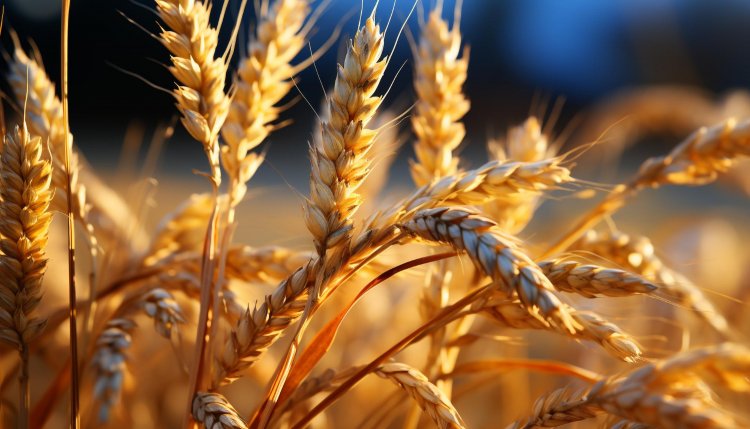Wheat: A Versatile Staple Crop Enriching Culinary Traditions and Human Health
Wheat, a fundamental cereal grain, has profoundly shaped human civilization, health, and culinary traditions throughout history. Belonging to the Triticum genus, wheat's versatility, nutritional richness, and adaptability have made it a cornerstone of global agriculture and cuisine. This article explores the historical significance of wheat, its nutritional composition, cultivation methods, health effects, and its diverse culinary applications across cultures.

Historical Significance:
Wheat's cultivation dates back to ancient times, with its domestication in the Fertile Crescent around 9600 BCE marking a pivotal moment in human history. This transition from hunter-gatherer societies to settled agricultural communities laid the foundation for civilization's emergence, fostering economic development, social complexity, and cultural exchange.
Nutritional Composition:
Wheat is a nutritional powerhouse, offering a rich array of essential nutrients vital for human health. The endosperm, comprising mainly starch, serves as a primary energy source. Moreover, wheat is an excellent source of protein, with gluten being its predominant protein component. Wheat also provides dietary fiber, vitamins (primarily B vitamins), and minerals such as iron, magnesium, and zinc, contributing to overall health and well-being.
Health Effects:
While wheat boasts numerous health benefits, its consumption can pose challenges for certain individuals. Gluten, a protein found in wheat, barley, and rye, can trigger adverse reactions in individuals with celiac disease, an autoimmune disorder characterized by gluten intolerance. For these individuals, consuming gluten-containing foods can lead to intestinal inflammation, malabsorption of nutrients, and various symptoms ranging from digestive discomfort to systemic manifestations.
Beyond celiac disease, some people experience non-celiac gluten sensitivity, exhibiting similar symptoms without the characteristic intestinal damage seen in celiac disease. Additionally, wheat allergies, though less common, can elicit allergic reactions ranging from mild hives to severe anaphylaxis.
However, it's essential to note that the majority of the population can enjoy wheat products as part of a balanced diet without adverse effects. Whole grains, including whole wheat, contribute to heart health, weight management, and digestive regularity, owing to their fiber content and nutrient density.
Culinary Uses:
Wheat's culinary versatility is unparalleled, with its derivatives featuring prominently in diverse cuisines worldwide. Wheat flour serves as a foundational ingredient in baking, producing an array of delectable treats such as bread, pastries, cakes, and cookies. The elasticity of gluten in wheat flour lends itself to dough formation, enabling the creation of diverse bread varieties, from fluffy loaves to crusty baguettes.
Pasta, another beloved culinary creation, is crafted from durum wheat semolina, yielding an array of shapes and textures, from spaghetti to lasagna. Noodles, a staple in Asian cuisines, are fashioned from wheat flour, offering a versatile canvas for savory broths, stir-fries, and salads.
Wheat's culinary prowess extends beyond baked goods and pasta to include breakfast cereals, crackers, couscous, bulgur, and various fermented products like beer and whiskey. Furthermore, wheat germ and wheat bran, nutritious byproducts of wheat processing, are valued for their health-promoting properties and culinary applications in cereals, baked goods, and snacks.
Cultivation Methods:
Wheat cultivation encompasses a diverse range of methods tailored to different climates, soil types, and agricultural practices. Varieties such as winter and spring wheat are cultivated worldwide, with cultivation practices including land preparation, seeding, fertilization, irrigation, and pest management. Modern agricultural innovations, such as precision farming techniques, genetic engineering, and sustainable practices, continue to enhance wheat productivity, quality, and environmental sustainability.
Contemporary Importance:
In the contemporary era, wheat remains a dietary staple for billions of people worldwide, providing sustenance, cultural significance, and economic livelihoods. Wheat-derived products feature prominently in diverse cuisines, reflecting regional traditions and culinary innovation. Furthermore, wheat serves as a vital feedstock for livestock, supporting the livestock industry's productivity and sustainability.
Challenges and Future Outlook:
Wheat cultivation faces numerous challenges, including climate change, water scarcity, pest and disease pressure, and socio-economic factors. Addressing these challenges requires interdisciplinary collaboration, technological innovation, and policy interventions to ensure food security, environmental sustainability, and equitable access to nutritious food.
In conclusion, wheat's profound influence on human health, civilization, and culinary traditions underscores its enduring importance in the modern world. By leveraging scientific advancements, sustainable practices, and inclusive policies, we can harness the potential of wheat to nourish current and future generations while safeguarding the health of our planet.
Disclaimer:
The information provided in this article is for educational purposes only and should not be considered medical advice. If you have any health concerns or are experiencing symptoms, it is important to consult with a healthcare professional, such as a doctor or clinic, for proper diagnosis and treatment. Always seek the advice of your doctor or other qualified health provider with any questions you may have regarding a medical condition. Do not disregard professional medical advice or delay in seeking it because of something you have read in this article.
#WheatHistory #NutritionalBenefits #GlutenFree #WholeGrains #HealthyEating #CulinaryUses #SustainableAgriculture #FoodSecurity #WheatCultivation #WheatResearch
What's Your Reaction?





















